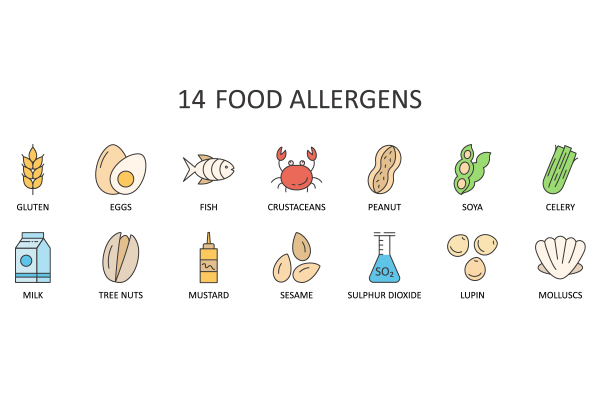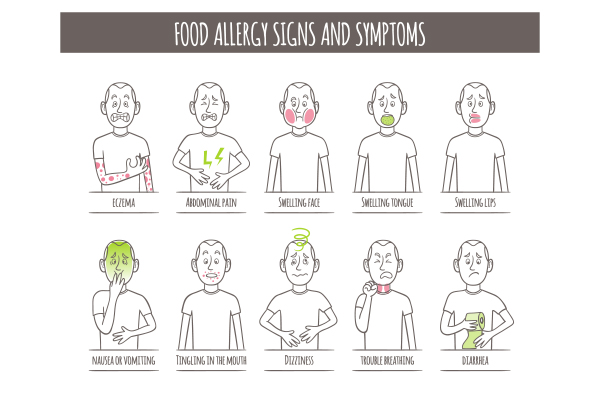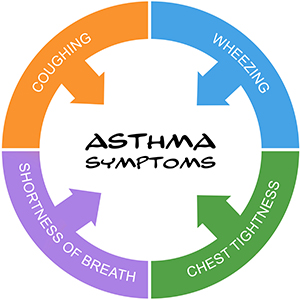Food Allergies
& Sensitivities
What is the difference between a food allergy and a food sensitivity?
Food allergies
A food allergy can be a serious medical condition. It can cause an immune system response that can affect many organs within your body. These responses can vary from moderate symptoms (developing a body rash) to life-threatening symptoms (including anaphylaxis, an immune system response in which a flood of chemicals are released into your body that can cause you to go into shock).
There are many different food allergens that are present in a wide variety of foods.

Symptoms food allergies cause include:
- Tingling of tongue, lips, or face
- Wheezing or trouble breathing
- Swelling of hands, feet, mouth, or tongue
- Blurry vision
- Fainting or near-fainting
- Rapid pulse or arrhythmia
- Body rash or hives
- Anaphylaxis

If you experience any of these symptoms, you should contact your primary care provider. In the case of a serious symptom, you should seek emergency care.
Treating serious food allergy symptoms involve comprehensive testing to confirm which foods or specific ingredients you are allergic to and how best to avoid them.
Our nutritionists at LifeStyle Medical Center can work closely with you to address food allergies by helping you obtain the tests you need and setting up a diet that ensures you get proper nutrition as you eliminate allergy-inducing ingredients from your diet.
Food intolerance (also known as food sensitivity)
Food intolerances generally have less serious symptoms than food allergies, however they can still cause a great deal of discomfort. Food sensitivities are more common than food allergies and reactions are more frequently related to just the gastrointestinal tract as opposed to other organs, including skin.
Lactose (dairy) intolerance and food additive intolerances, such as MSG or flavor enhancers, are the most common food sensitivities.
Food intolerance is, indeed, common. For example, a degree of lactose intolerance is common in African, Asian, Native American, and Alaskan Native populations. By adulthood, 70% of African Americans have some degree of lactose intolerance.
Digestive tract symptoms related to food intolerances include:
- Abdominal bloating, pain, and cramping
- Excess gas
- Nausea and possible vomiting
- Nonbloody diarrhea
Unlike some serious food allergies, food intolerances do not cause fainting, abnormal heart rates, seizures, shock, bloody or black stools, muscle weakness, or seizures.
Tips for uncovering food intolerances
Tests can confirm food intolerance for certain foods or substances. However, there is not an effective test for many foods. If you experience digestive tract symptoms, it is smart to keep a food consumption journal to note when symptoms flare up. You can then uncover the specific foods that cause your symptoms, share the journal with your dietician, and come up with strategies for avoiding those foods in the future. Treatments depend on the particular intolerance.
What are the most common food sensitivities?
- Lactose: lactose is a sugar found in milk and dairy products. People with lactose intolerance do not make enough lactase enzyme to break down lactose. This is the most common food intolerance.
- Histamines: histamines are naturally occurring chemicals found in cheese, bananas, avocados, chocolate, red wine, and some white wines, among other foods. People with histamine intolerance do not make enough diamine oxidase enzyme to break down histamine.
- Gluten: gluten is a protein found in wheat, barley, and rye. People with gluten sensitivity have a hard time digesting gluten. Gluten sensitivity is not the same as celiac disease which is an autoimmune disease in which gluten damages the lining of the small intestine.
Lactose intolerance treatments
Generally, lactose intolerance is treated by avoiding or limiting lactose-containing foods or with drug therapy, such as an over-the-counter product that works as an enzyme to help you digest the lactose.

Dairy foods contain important nutrients such as phosphorus, calcium, and other important minerals and vitamins. Therefore, it is not usually recommended that you avoid lactose altogether unless the intolerance has been confirmed with testing and cannot be mitigated in some way. If the intolerance is quite severe, you can discuss with your nutritionist whether a multivitamin or additional calcium and vitamin D supplementation should be taken.
Some food allergies can trigger asthma
Allergies and asthma often occur together. The same substances that cause hay fever and food allergy symptoms can also cause asthma symptoms, including shortness of breath, wheezing, and chest tightening. This is referred to as allergic asthma or allergy-induced asthma. Pollen, dust mites, and pet dander are common triggers. However, in some people, food allergies can cause asthma symptoms as well.
You should work with your medical providers and nutritionist until your allergies and/or asthma are under control and your quality of life is improved.

Here at LifeStyle Medical Center we can evaluate your food intolerances and help you create a diet that meets your nutritional needs while avoiding foods that cause gastrointestinal discomfort. If needed, we can refer you to an allergist or gastroenterologist for further evaluation. Call us today @ 919-354-7077
Are you ready to take the path to a healthier you?
Take control of your diet and health today. Better health IS within your reach. Take the first step today.
Call us today @ (919)354-7077
Sources:
- Centers for Disease Control and Prevention, https://www.cdc.gov/.
- Mayo Clinic, https://www.mayoclinic.org/.
- Johns Hopkins Medicine, https://www.hopkinsmedicine.org/health.
- Cleveland Clinic, https://my.clevelandclinic.org/health/diseases.
